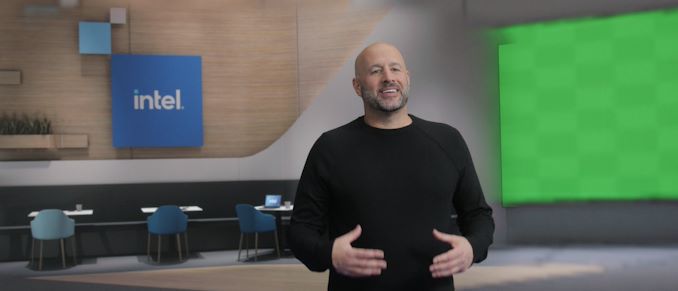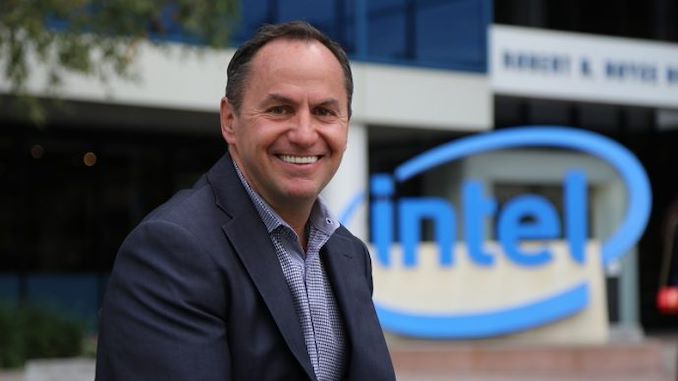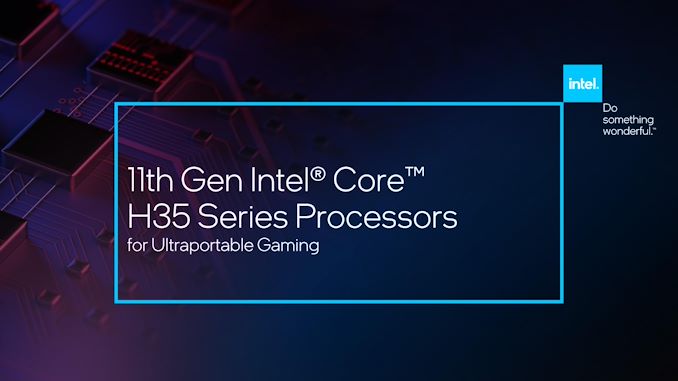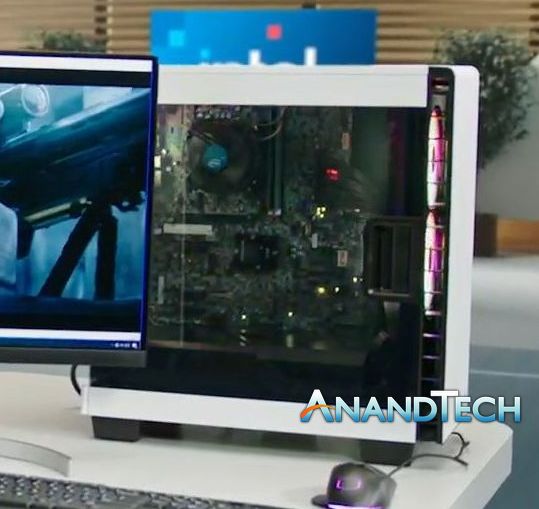Intel at CES 2021: Ice, Tiger, Rocket, Jasper, and Alder Lake
by Dr. Ian Cutress on January 11, 2021 4:32 PM EST
Despite only having a 30 minute press event at this year’s annual CES trade show, Intel had a lot to discuss about its plans through the next 12 months. The company touched upon five key processor architectures and product segments that will dictate where a lot of its FY2021 will come from. This is essentially a yearly roadmap set of announcements, without actually giving us the roadmap.
Carousel Image is of Intel's Greg Bryant, GM of the Client Computing Group, presenting at CES.
We’ve had a lot of Intel news today, which we separated out into separate news posts for ease of use. This is a handy quick-use guide to click through to any of our analysis
An Evening with Intel CEO Bob Swan: Roundtable Q&A
Intel surprised us by offering a chance to ask questions to the man in charge, CEO Bob Swan. It is rare for Intel to offer access to its C-Level executives to the tech press, and as a result we had to think of some nail biters to ask him that only he could answer. Our time was short, and ended up being about 15 minutes for the half-dozen of us to ask and get answers, but it was good to hear answers relating to Intel’s fab strategy, what Intel can do when it comes to outsourcing, and whether Bob considers Intel’s technical or financial position as more important.
Hot Off The Press: Ice Lake Xeon Now In Production
Many of Intel’s recent challenges stems from its inability to drive its 10nm process into two of the key revenue generating areas for the company: desktop and server. We were expecting to see Intel’s 10nm Ice Lake Xeon Scalable at the end of last year, but it passed by without a peep. Today Intel is announcing that it has started production, although earlier in the year Intel said it was already ramping production, and other sources tell us that Intel has already launched the hardware, and is shipping to customers? It all got very confusing.
The Newest Desktop On The Block: Rocket Lake’s Core i9-11900K
Intel has been teasing its next generation Rocket Lake desktop processors for several months now, with arrows pointing to PCIe 4.0 and we already know about the backported CPU and GPU cores. There are big questions as to what this means for performance and power, and Intel answered exactly zero of our questions, but did decide to preview some of the gaming performance, as well as give us concrete numbers on frequencies. There’s also a launch of many, many 500-series motherboards.
Laptops Now Have Options: Tiger Lake 35W, Tiger Lake 45W
On the notebook side of the equation, Intel has two new product families for its OEM partners to play with. The closest to launch is the new Tiger Lake H35 series, which are Intel’s regular 15 W processors beefed up to a 35 W power mode, and scraping 5.0 GHz. A little further away is the traditional 45W H-Series processors, featuring up to eight cores. We’ve got details on both.
Business Customers Matter Too: Intel Tiger Lake gets vPro
Given the massive growth of notebook sales this year to the business sector, demand for business class notebooks is growing fast. These business notebooks need special security features, as well as out-of-band management, and thus require Intel’s vPro line of hardware. Intel is meeting that need by putting the latest 15W Tiger Lake processors into its vPro line. More details of the additional security features that come with the hardware, such as CET, in our coverage.
Chromebooks for Education: 10nm Jasper Lake Comes To Life
Here’s an announcement we weren’t really expecting to get in detail, but we’re glad we did: Intel is updating its Pentium Silver and Celeron processor line with 10nm Jasper Lake processors. What makes this an exciting launch is that these are powered by Intel’s latest generation Tremont Atom cores that do x86 a little differently than most. We can’t wait to get our hands on one, especially as they filter into Windows machines and mini-PCs. More details inside.
Alder Lake?
Mentioned briefly in our pre-show discussions under NDA at the time, while there’s no specific news on Intel’s Alder Lake platform coming later in 2021, CEO Bob Swan did tell us that it will be Intel’s most ‘power scalable’ SoC for desktop and mobile. More details to follow later in the year.
Update: Intel showed off this system during their CES press conference.
Intel said it was an Alder Lake system, up and running with Windows. Obviously early silicon and a test board so far, but it's a step in the right direction. It was confirmed for launch in the second half of the year.
Related Reading
- Interview with Intel CEO Bob Swan
- Intel at CES 2021: Overview
- Intel at CES 2021: Press Event Live Blog
- Intel Ice Lake Xeon in Production
- Intel 11th Gen Desktop Rocket Lake Core i9-11900K ‘Preview’
- Intel 11th Gen Tiger Lake-U Boosted to 35W
- Intel 11th Gen Tiger Lake-H with 8 cores
- Intel 11th Gen Tiger Lake Goes vPro
- Intel’s Next Gen Tremont Atom in Jasper Lake for Q1

















44 Comments
View All Comments
Oberoth - Thursday, January 14, 2021 - link
The only way I can see Intel staying relevant over the next few years is if they do strike a deal with TSMC but goodness knows what that would look like. TrendForce seem to be claiming that TSMC will be making 5nm Intel chips at the end of this year and 3nm chips in 2022.I can't see TSMC having the 3nm capacity in 2022 to serve all of Apple's needs, PLUS you would think still put AMD before Intel as they are a long term FABless partner, ON TOP of also having enough spare capacity to then fulfil Intel's requirements.
We have to look at it from TSMC's point of view, they already can't make enough chips for Apple and AMD, these customers will always come first because in a few years Intel might say thank you very much, our FABs are working now and walk away but TSMC have lost Apple or AMD to Samsung.
The point is TSMC really doesn't need Intel, they are sold out without them and it really shouldn't come down to Intel offering a little more money right now because that would be like taking a $10,000 bribe knowing it will cost you your $50,000 a year career you have had for years and are very happy at.
We will have to see what happens. I really want it to be true as it would be amazing for us as customers but I would think it can only happen if TSMC has the capacity, which it might have but I don't believe that to be the case given the shortages we are having right now.
Maybe TSMC is forcing Intel into signing a 10 year minimum order deal which would give TSMC peace of mind to risk upsetting Apple or AMD but it's still a dangerous game for them to play.
Personally I think the best and possibly only way this partnership can work is if Intel licenced TSMC's IP for the 7nm to 3nm nodes, this would then cover everything up to the move to GAAFET. As I've said TSMC doesn't have anywhere near the capacity to serve their long term customers and then also provide Intel with any meaningful capacity but Intel has the capacity just not the IP. So put these two together and TSMC could make an absolute fortune by licencing their node knowhow to Intel and Intel could almost instantly dig itself out of it FAB hole it's in, win-win.
I'll try to speak to Pat and see what he thinks.
Statusswag - Thursday, January 21, 2021 - link
Nice Article Hear is all types of status quotes images are there are there visit Silence Quotes for more quotes on. <a href="https://silencequotes.com/misunderstanding-quotes/... 101+ Best Misunderstanding Quotes For You </a>Statusswag - Tuesday, January 26, 2021 - link
Nice Article <a href="https://statusswag.com/status-video/punjabi-status... punjabi status video </a>Statusswag - Saturday, November 20, 2021 - link
Nice Article<a href="http://sewwhatnews.com/">Sew What News</a>